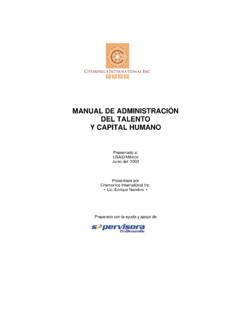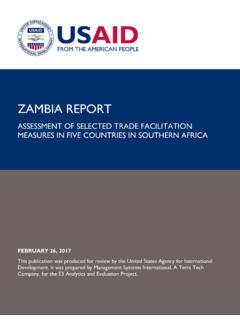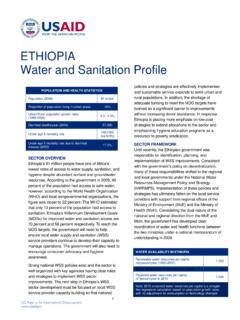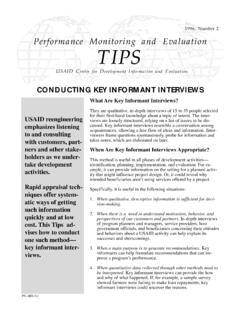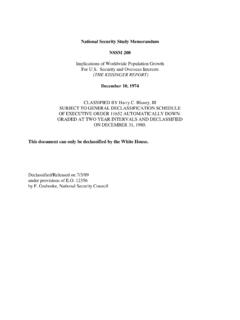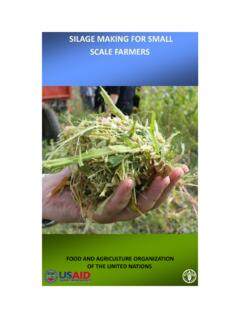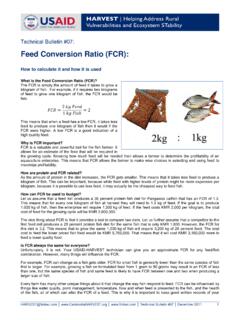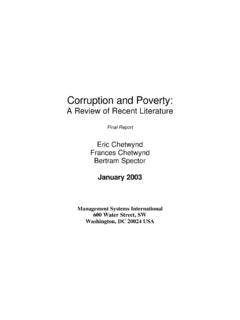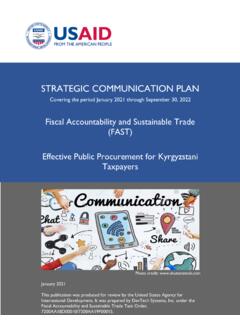Transcription of LOW-VOLUME ROADS ENGINEERING
1 Best Management PracticesField GuideLOW-VOLUME ROADSENGINEERINGG ordon Keller&James SherarLOW-VOLUME ROADS BMPS: iLow-VLow-VLow-VLow-VLow-Volume Rolume Rolume Rolume Rolume RoadsoadsoadsoadsoadsEngineeringEngineer ingEngineeringEngineeringEngineeringBest Management PracticesField GuideByGordon Keller, PEGeotechnical EngineerUSDA, Forest ServicePlumas National Forest, CaliforniaandJames Sherar, PELogging EngineerUSDA, Forest ServiceNational Forests of North CarolinaProduced forUS Agency for International Development (USAID)In Cooperation withUSDA, Forest Service, International Programs&Conservation Management Institute,Virginia Polytechnic Institute and State UniversityJuly 2003 LOW-VOLUME ROADS BMPS: iiphoto hereInformation contained in this document has been developed for the guidance of road builders,road managers, and resource specialists in most geographic areas to help build better, more cost-effective ROADS , and ROADS that minimize adverse environmental impacts and protect water Department of Agriculture (USDA) or Agency for International Development(USAID) assumes no responsibility for the interpretation or use of this information.
2 The use oftrade, firm, or corporation names is for the information and convenience of the reader. Such usedoes not constitute an official evaluation, conclusion, recommendation, endorsement, or approvalof any product or service to the exclusion of others that may be Department of Agriculture and Agency for International Development prohibitdiscrimination in all their programs and activities on the basis of race, color, national origin, sex,religion, age, disability, political beliefs, sexual orientation, or marital or family status. (Not allprohibited bases apply to all programs.) Persons with disabilities who require alternative means forcommunication of program information (braille, large print, audiotape, etc.) should contact USDA sTARGET Center at (202)-720-2600 (voice and TDD).To file a complaint of discrimination, write USDA, Director, Office of Civil Rights, Room 326-W, Whitten Building, 1400 Independence Avenue, SW, Washington, 20250-9410, or call(202) 720-5964 (voice and TDD).
3 USDA is an equal opportunity provider and ROADS BMPS: iiiLOW-VOLUME ROADS ENGINEERINGBest Management Practices Field GuideFOREWORDThe Conservation Management Institute (CMI) in the College of Natural Resources atVirginia Tech is dedicated to helping apply sound scientific principles to the managementof renewable natural resources around the world. Access is an important considerationin many settings not only to facilitate utilization of natural resources, but also to enable peopleto reach markets for their products and health services. However, it is vital that ROADS con-structed provide adequate access while following sound practices for environmental protectionwherever possible. Improperly constructed ROADS can negatively impact everything from terres-trial plant populations and soil conservation efforts to water quality and populations of aquaticorganisms in receiving manual was originally published in Spanish as Practicas Mejoradas de CaminosForestales by the Agency for International Development (USAID) for use throughoutLatin America, and has proven valuable in helping to protect forest-based resources.
4 It becameclear that the practical advice offered in this manual could be of value to resource managersthroughout the world. So, to reach this broader audience and inspired by the original Spanishwork, CMI and the USDA Forest Service have collaborated to produce this updated version inEnglish. We hope that the materials presented here are useful to project grew from our collaboration with Gerald Bauer, of the US Forest Service, onnatural resource education programs in Latin America. Mr. Bauer was a contributor to theoriginal manual and found the publication in great demand. This collaboration exemplifies ourinvolvement with USAID and the Forest Service on many natural resource projects. Weencourage you to contact USFS or CMI if we can be of assistance in your conservation , we acknowledge the notable efforts of Julie McClafferty of CMI, who was instrumentalin preparing this manual for R. Murphy, PhD.
5 , Director, CMI Hammett, PhD., Faculty Fellow, CMI and Coordinator of International Programs, Collegeof Natural Resources Keller, PE, Geotechnical Engineer, USFS Sherar, PE, Logging Engineer, USFS LOW-VOLUME ROADS BMPS: ivLOW-VOLUME ROADS BMPS: vACKNOWLEDGMENTSALARGE NUMBER OF INDIVIDUALS have been involved in the developmentof the MinimumImpact LOW-VOLUME ROADS Manual and this subsequent LOW-VOLUME RoadsEngineering Best Management Practices Field Guide. These individuals have had thevision and commitment to preserving and enhancing the quality of our environment, while alsorecognizing the need for good ROADS . Futhermore, they recognize the planning, design, mainte-nance, and overall management necessary to have good for this project hasprincipally been provided by the US Agency for International Development (USAID), theGlobal Bureau, and the Forestry Team, with contributions from the USDA, Forest Ser-vice, Office of International Programs, the Pacific Southwest Region, and the PlumasNational original Spanish version of this document was produced with the help of Ramon Alvarez,Roberto Medina, and Atilio Ortiz with USAID, Honduras.
6 The authors are particularly grateful forthe support of Jerry Bauer, Alex Moad, and Michelle Zweede with the International Programsoffice of the Forest Service; Jim Padgett and Nelson Hernandez from the Washington Office,USFS; Scott Lampman, Paul DesRosiers, and Mike Benge with the Agency for InternationalDevelopment; and the steadfast support from our Plumas National Forest drawings presented in this document come from a variety of sources, as indicated, and mosthave been redrawn or adapted with the artistic talent of Jim Balkovek, Illustrator, and Paul Karr,a retired Forest Service Engineer. Scanning, labeling, and computer manipulation of figures for thisfield guide have been accomplished with the skill and patience of Lori Reynolds of ReynoldsGraphics in Quincy, California. Translation of portions of this Field Guide and the original Mini-mum Impact LOW-VOLUME ROADS Manual was skillfully accomplished by Alejandra Medina of theVirginia Tech Transportation sincere thanks to the many professionals and laymen who gave their time in reviewing and editingthe document, as well as making valuable suggestions regarding the form and content of this FieldGuide.
7 Particular thanks to Jill Herrick, Forest Service, for her valuable contributions andassistance with editing this guide, assistance with the Definition of Terms and References, andoverall content review, as well as to Michael Furniss, Charlie Carter, Jerry Short, Tim Dembosz,and Ozzie Cummins for their numerous suggestions and ideas on drainage and other issues. Thanksto Richard Wiest, author of A Landowner s Guide to Building Forest Access ROADS , for hisinspiration and ideas on format and layout. Other individuals involved in review and editing includeLeslie Lingley of Leslie Geological Services; Marty Mitchell of Clear Water West; Alfred Logiewith the International Programs office of the Federal Highway Administration (FHWA); MikeBenge and Eric Peterson with U. S. Agency for International Development; Dr John Metcalf fromLSU/PIARC World ROADS Association; Dr. Francis Greulich, Forest Engineer at the University ofWashington; Dr.
8 Allen Hathaway, Geologic Engineer at the University of Missouri-Rolla; David LOW-VOLUME ROADS BMPS: viOrr, PE with the Cornell University Local ROADS Program; Prof. Raymond Charles, University ofWest Indes; Art Klassen, Tropical Forestry Foundation; James Schenck and Wilson Castaneda,Cooperative Housing Foundation-Guatemala; Harold Tarver with Africare; Wes Fisher with TellusInstitute; and Sandra Wilson-Musser, Corky Lazzarino, Armando Garza, Gary Campbell, KenHeffner, Terry Benoit, Allen King, John Heibel, William Vischer, and Greg Watkins, ForestService employees dedicated to watershed protection and building good of the photos used in this manual either belong to the authors, Gordon Keller and JamesSherar, or to Jerry Bauer, co-author on the Minimum Impact LOW-VOLUME ROADS belong to individuals as indicated on the specific photo. The retaining wall photo on thecover was provided by Michael , the authors wish to give special thanks to Tom Hammett at Virginia Tech for his connec-tions and facilitation of this project and Julie McClafferty of the Conservation Management Insti-tute and Patty Fuller of Poplar Hill Studios in Blacksburg, Virginia, for their magic in layout andpublication of this guide and making it look the way it does.
9 Last, and by no means least, a big hugto our wives, Jeanette and Julie, and families for their patience and support during this project! LOW-VOLUME ROADS BMPS: viiPREFACETHE AUTHORS ARE GRATEFULfor the opportunity to develop this guide for the US Agency forInternational Development (USAID) with the cooperation of the USDA, the Forest Service,the Office of International Programs, and the International Programs Department at VirginiaPolytechnic Institute and State University. The original development of this ROADS Best ManagementPractices (BMP) Field Guide was funded by USAID/Honduras, in support of their ForestryDevelopment Program (FDP) and their National Forestry School (ESNACIFOR). It has sincebeen revised and expanded to be consistent with and complement the training manual titled Minimum Impact LOW-VOLUME ROADS for ROADS work in developing LOW-VOLUME ROADS ENGINEERING Best Management Practices Field Guide is intended toprovide an overview of the key planning, location, design, construction, and maintenance aspectsof ROADS that can cause adverse environmental impacts and to list key ways to prevent Management Practices are general techniques or design practices that, whenapplied and adapted to fit site specific conditions, will prevent or reduce pollution and maintainwater quality.
10 BMPs for ROADS have been developed by many agencies since ROADS often have amajor adverse impact on water quality, and most of those impacts are preventable with goodengineering and management practices. ROADS that are not well planned or located, not properlydesigned or constructed, not well maintained, or not made with durable materials often have nega-tive effects on water quality and the Guide presents many of those desirable practices. Fortunately, most of these Best Manage-ment Practices are also sound ENGINEERING practices and ones that are cost-effective by prevent-ing failures and reducing maintenance needs and repair costs. Also keep in mind that best isrelative and so appropriate practices depend to some degree upon the location or country, degreeof need for improvements, and upon local laws and regulations. Best practices are also constantlyevolving with guide tries to address most basic ROADS issues in as simple a manner as possible.
